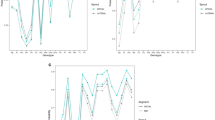Abstract
The activity and longevity of Soybean mosaic virus (SMV) in soybean callus culture were investigated with 11 SMV strains which are distinguished by differential reactions on soybean cultivars [Glycine max (L.) Merr.]. Dual cultures (soybean callus and SMV) were initiated by direct culture of SMV-infected leaves from susceptible soybean plants on Msoy and MS agar medium. Established SMV-callus cultures were maintained at 25 °C under light, subcultured to fresh MS medium at 2-month intervals or as necessary, and assayed periodically for virus infectivity. The infected calluses on MS medium grew better and stayed active longer than those on Msoy medium. At 10–15 °C, calluses and SMV were viable and active for 13–15 weeks or longer without subculture. The infectivity of SMV from callus cultures was comparable with that of SMV from infected plants, and remained stable for more than a year through five successive subcultures. Callus tissues of dual cultures were uniformly infected by SMV, thus ensuring infectious subcultures by random transfers. Production of in vitro inoculum can be significantly increased by multiple subcultures. Biological integrity of the SMV cultures was maintained with no change of viral virulence and pathotype. The method is of value for preserving a collection of SMV strains in a highly infectious and readily available form and reduces the chance of contamination or loss in viability.
Similar content being viewed by others
References
Bos L (1969) Experiences with a collection of plant viruses in leaf material dried and stored over calcium chloride and a discussion of literature on virus preservation. Meded. Rijksfac. Landbwet. Gent. 34: 875-887
Bos L (1977) Persistence of infectivity of three viruses in plant material dried over CaCl2 and stored under different conditions. Neth. J. Plant Path. 83: 217–220
Chen P, Buss GR, Roane CW & Tolin SA (1991) Allelism among genes for resistance to Soybean mosaic virus in strain-differential soybean cultivars. Crop Sci. 31: 305-309
Chen P, Buss GR, Roane CW & Tolin SA (1994) Inheritance in soybean of resistant and necrotic reactions to Soybean mosaic virus strains. Crop Sci. 34: 414-422
Cho EK & Goodman RM (1979) Strains of Soybean mosaic virus: classification based on virulence in resistant cultivars. Phytopathology 69: 467-470
De Wijs JJ & Suda-Bachmann F (1979) The long-term preservation of Potato virus Y and Watermelon mosaic virus in liquid nitrogen in comparison to other preservation methods. Neth. J. Plant Path. 85: 23-29
Duran-Vila N, Cambra M, Medina V, Ortega C & Navarro L (1989) Growth and morphogenesis of citrus tissue cultures infected with Citrus tristeza virus and citrus infectious variegation virus. Phytopathology 79: 820-826
Hildebrandt AC (1973) Tobacco mosaic virus in plant tissue culture. In: Kruse PF & Patterson MK Jr. (eds) Tissue Culture Methods and Applications (pp. 549-558). Academic Press, New York
Hollings M & Stone OM (1970) The long-term survival of some plant viruses preserved by lyophilization. Ann. Appl. Biol. 65: 411-418
Hunst PL & Tolin SA (1982) Isolation and comparison of two strains of Soybean mosaic virus. Phytopathology 72: 710-713
Ingram DS (1973) Growth of plant parasites in tissue culture. In: Street HE (ed) Plant Tissue and Cell Culture (pp. 392-421). Blackwell Sci. Publ, Oxford
Karp A, Risiott R, Jonis MGK & Bright SWJ (1985) Chromosome doubling in monohaploid and dihaploid potatoes by regeneration from cultured leaf explants. Plant Cell Tiss. Org. Cult. 3: 363-373
Mckinney HH & Silber G (1968) Methods of preservation and storage of plant viruses. In: Maramorosch K & Koprowski H (eds) Methods inVirologyVol. 4 (pp. 491-501). Academic Press, New York
Murashige T & Skoog F (1962) A revised medium for rapid growth and bioassays with tobacco tissue cultures. Physiol. Plant 15: 473-497
Navas Castillo J, Moreno P & Duranvila N (1995) Citrus psorosis, ringspot, cristacortis and concave gum pathogens are maintained in callus-culture. Plant Cell Tiss. Org. Cult. 40: 133-137
Pelah D, Altman A & Czosnek H (1994) Tomato yellow leaf curl virus - DNA in callus-cultures derived from infected tomato leaves. Plant Cell Tiss. Org. Cult. 39: 37-42
Raychaudhuri SP (1966) Plant viruses in tissue culture. In: Smith KM & Lanffer M (eds) Advances in Virus ResearchVol. 12 (pp. 175-206). Academic Press, New York
Reinert J & Yeoman MM (1982) Soybean bioassay system. In: Reinert J & Yeoman MM (eds) Plant Cell and Tissue Culture: A Laboratory Manual (pp. 20-21, 76279). Springer-Verlag, Berlin, New York
Schafer-Menuhr A (1985) In vitro techniques: propagation and long-term storage. In: Schafer-Menuhr A (ed) Advances in Agricultural Biotechnology (pp. 137-175). Martinus Nijhoff /Dr W. Junk Publishers
Sinclair JB (1982) Soybean mosaic. In: Sinclair JB (ed) Compendium of Soybean Disease (pp. 56-58). American Society of Phytopathology, St. Paul, MN
Timoshenko NA, Vnuchkova VA, Vishnichenko VK & Zavriev SK (1989) Preservation of Potato virus Y in callus tissue culture of Nicotiana glutinosa. Sov. Agric. Sci. 11: 12-16
Toyoda H, Chatani K, Matsuda Y & Ouchi S (1989) Multiplication of Tobacco mosaic virus in tobacco callus tissues and in vitro selection for viral disease resistance. Plant Cell Rep. 8: 433-436
Tu JC & Buzzell RI (1987) Stem-tip necrosis: a hypersensitive, temperature dependent, dominant gene reaction of soybean to infection by soybean mosaic virus. Can. J. Plant Sci. 67: 661-665
Walkey DGA (1985) Storage of virus isolates. In: Walkey DGA (ed) Applied Plant Virology (pp. 107-108). Chapman and Hall, London, New York
Author information
Authors and Affiliations
Rights and permissions
About this article
Cite this article
Chen, P., Buss, G., Tolin, S. et al. A tissue culture method for the preservation of Soybean mosaic virus strains. Plant Cell, Tissue and Organ Culture 74, 185–192 (2003). https://doi.org/10.1023/A:1023915932392
Issue Date:
DOI: https://doi.org/10.1023/A:1023915932392




